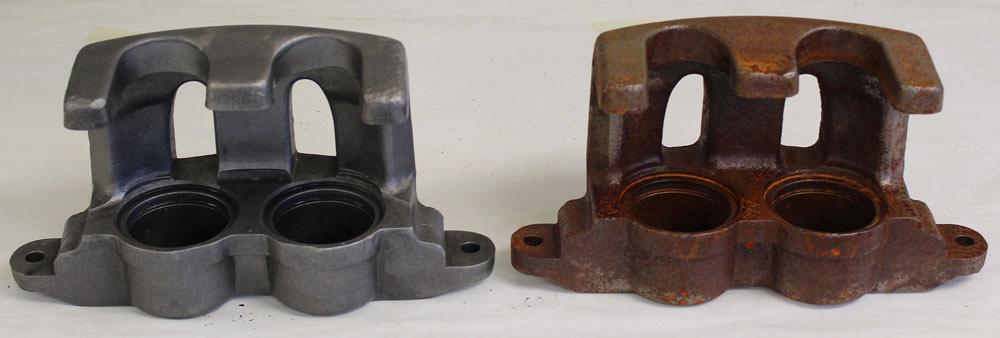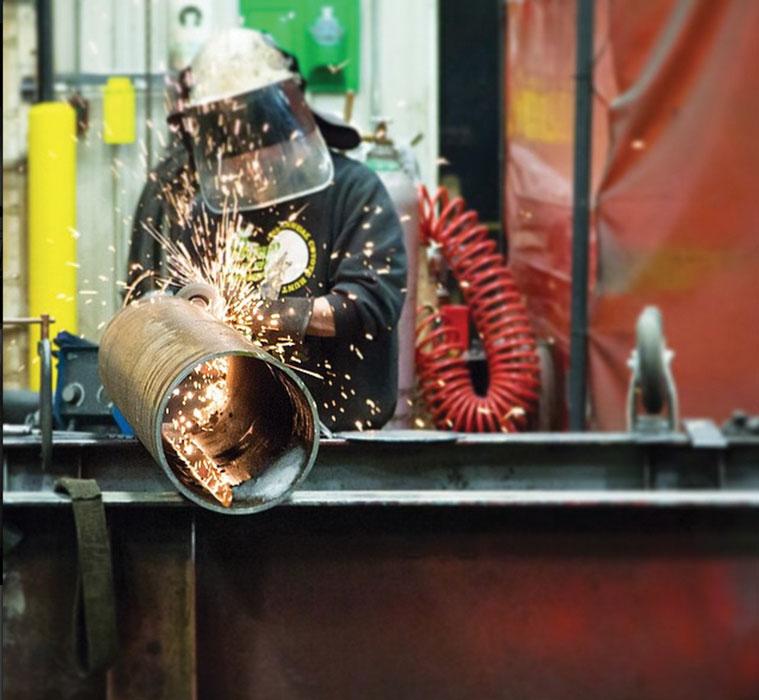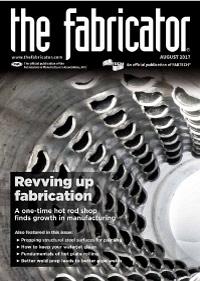Contributing editor
- FMA
- The Fabricator
- FABTECH
- Canadian Metalworking
Categories
- Additive Manufacturing
- Aluminum Welding
- Arc Welding
- Assembly and Joining
- Automation and Robotics
- Bending and Forming
- Consumables
- Cutting and Weld Prep
- Electric Vehicles
- En Español
- Finishing
- Hydroforming
- Laser Cutting
- Laser Welding
- Machining
- Manufacturing Software
- Materials Handling
- Metals/Materials
- Oxyfuel Cutting
- Plasma Cutting
- Power Tools
- Punching and Other Holemaking
- Roll Forming
- Safety
- Sawing
- Shearing
- Shop Management
- Testing and Measuring
- Tube and Pipe Fabrication
- Tube and Pipe Production
- Waterjet Cutting
Industry Directory
Webcasts
Podcasts
FAB 40
Advertise
Subscribe
Account Login
Search
Preparing structural steel surfaces for painting, coating standards
Adhesion is the reason for the season
- By Kate Bachman
- August 10, 2017
- Article
- Cutting and Weld Prep
Mill scale. Dirt. Laser scale. Rust. Heat-treat scale. Grease. Dust. And did we mention heavy mill scale? When these come between your structural steel and your paint or coating, bad things happen. And when the steel you fabricate holds up bridges, overpasses, buildings, and stadiums, bad things are big bad things.
So what are structural steel fabricators doing about surface preparation, and what options are available? Surface preparation can run from simple chemical cleaning to abrasion methods such as grinding and abrasive blasting. How to know which methods to use?
Many fabricators’ projects come with surface specifications prescribed by The Society for Protective Coatings (SSPC) standards (see Figure 1). The methods used are specified in the contract or project documents, according to SSPC Certification Program Manager Joe Berish, PCS, MCI, who administers the program. The primary documents are the specification and product data sheets, he said. The data sheets provide the surface preparation that the coatings manufacturer used when it tested its materials and demonstrated the performance applicable to the intended use and service life, according to Berish.
“The coating systems manufacturers test for adhesion and performance. When they do that, they do it with a specified profile range. For example, if you were using a certain brand’s product on a bridge, the data sheet might tell you that it was tested in a laboratory at a 2- to 4-ml profile, and this would mean you might need 3 to 5 ml of paint. It’s going to give you the profile range, the thickness of the coating that you can apply, how much thinner you can and cannot use … whether you can put it over a pickled surface or a chemical-treated surface or an abrasive-blasted surface. It’s going to tell you all of that information.
“What that means is that the coating manufacturer, in the laboratory, has taken a piece of metal that met that description and they have actually tested it and here are the test results,” Berish continued. “And to get the paint manufacturer to provide a warrantee, it has to be known that it was applied under those same conditions.”
The surface preparation’s standard name indicates the method used, and all surface preparation standards use the prefix SP, he said. “For example [SSPC] SP 5, SP 6, and SP 10 are all defined as abrasive blast cleaning standards. SSPC SP 8 is the standard for pickling as a means of surface preparation. The differences in all of these standards are the cleaning methods, cleanliness levels, and surface profile. Different methods may produce a similar level of cleanliness, but each will still result in differences such as surface profile or flash rusting.”
Why would a customer choose abrasive or blast cleaning over pickling or solvent cleaning—or vice versa? “The contract or specification and coating product data sheet may require a surface profile which cannot be achieved by pickling, chemical stripping, or solvent cleaning,” Berish said. “Also, the coating being applied may not be compatible with all methods of surface preparation. In addition, some choices may be made dependent on the availability of equipment that the fabricator may have.”
Cost is also a consideration, which depends on the amount of surface area to be prepared, Berish continued. “For example, if it is just a few square feet and does not require a surface profile, chemical stripping may be cost-effective; conversely, if there are several thousand square feet of surface to be prepared, pickling or abrasive blasting would be more cost-effective.”
Whether or not the waste produced would need to be disposed of as hazardous has an effect on the methods used as well.
“The customer will give the fabricator a build sheet, if you will,” Berish said. “’We want it to be fabricated like this: the bolts located here, with this diameter.’ It’s the same with the surface condition. Just by the material they’re going to use, they’re going to go to that material data sheet that will tell what surface standard is compatible with that material—SP 1, SP 2 or 3, SP 6 or SP 10.”

Figure 1
The SSPC’s surface preparation’s standard name indicates the method used, and all surface preparation standards use the prefix SP.
SSPC-SP 1: Solvent Cleaning
The first line of defense is simply cleaning the structural member with acetone, a thinner, or another type of solvent.
“Cleaning with a solvent and a cloth is a precursor to every other surface preparation standard out there. It’s a given,” Berish said.
Cortec® Technical Service Engineer John Wulterkens said that fabricators can remove mill scale, oxides, and corrosion from the metal surface using either VpCI®-422 or VpCI-426 water-based liquids (see Figure 2). “VpCI-422 is more ‘ecofriendly’ (biodegradable); VpCI-426 is stronger and works faster. Depending on the application, the gel versions of both products can be used on vertical or overhead surfaces, or on parts that cannot be treated in a dip bath.”
After the scale is removed, cleaning and neutralization should be performed with a water-based alkaline cleaner, he added. “This will leave behind a cleaner surface for painting, coating, and welding. The cleaners (and rust/oxide/scale removers) contain flash corrosion inhibitors, so after the neutralization and cleaning stage, the surface will remain flash rust-free for up to a week, depending on conditions.”
SSPC 2, SSPC 3: Hand Tool, Power Tool Cleaning
Bass Mechanical, a structural steel fabricator in Elizabethtown, Pa., has 40- by 80-foot drive-through bays that handle both medium- and large-scale structural steel fabrication. The company fabricates and welds carbon steel, aluminum, stainless, and nickel aluminum into trusses, box girders, plate girders, beams, columns, mezzanines, stairways, and railings.
Before sending its products out for coating, the company performs some minimal surface prep, according to Jerry Miller, chief operations officer. “We usually go to an SSPC-SP 2 or SP 3, which requires the steel to be free of grease, moisture, contaminants, heavy mill scale, and rust.” Miller said the company uses a thinner and a power tool to remove the contaminants. Then it uses high-pressure air to blow the dirt or dust and rust away,” Miller said.
Standards SP 2 and SP 3 require the use of a hand or power tool to satisfy the requirement, Berish said. “By standard, SP 2 means that the surface is clean of all oils and loosely inherent material. So SP 2 is hand cleaning with the use of hand tools—a wire brush or a scraper. The use of a chemical treatment alone cannot make it an SP 2 because you cannot remove inherent materials with chemicals alone.” SP 3 is the standard for cleaning and removing loosely inherent material using a power tool, such as a grinder (see Figure 3).
SSPC-SP 6, Blast Cleaning
To achieve an SSPC-SP 6 grade surface cleanliness, fabricators use a shotblast cleaning machine (see Figure 4). An SSPC-SP 6 finish is the most common for structural steel, according to Alex Berghouse, product manager for blast equipment at Peddinghaus, Bradley, Ill. “That will get all the difficult residue off the steel—mill scale, rust, dirt, and so forth.”
Berghouse explained how the blast machines work: The raw structural steel enters the shotblast machine, and as the material passes through the zero point, the operation is initiated. The turbines engage when the machine senses the material’s presence. The turbines throw the shot or abrasive onto the material to clean the steel. With an adjustable brush mechanism, the machine cleans off the excess abrasive and returns it to the hopper to be recycled and used again and again. The process continues until the full piece passes through the entire turbine orientation. “The speed can vary, but it is normally set about 3 to 5 feet per minute, depending on the structural profiles that are being processed. So the steel goes in laden with rust, dirt, and scale and comes out clean and ready for the next fabrication process,” Berghouse said.
“The primary application for the blast determines the number of turbines you need to achieve the proper clean surface requirements,” Berghouse said.

Figure 2
At left is a metal surface with corrosion removed using VpCI®-422; at right, a metal surface before the corrosion was removed. Photos courtesy of Cortec Corp., St. Paul, Minn.
“There are all different types of classifications for blast cleaning, depending not only on the postprocess, such as painting or welding, but also on which application, such as for bridge construction or building construction,” he said.
Before entering the blast machine, a structural steel member must be cleaned of oil and grease, Berghouse cautioned. “If a structural member goes into the blast system with any kind of excessive moisture, oil, or liquids, a filtering problem can arise. The filter cartridges will become gummed up with contaminants and won’t filter properly.”
Peddinghaus designs its filtration system with inverted, conical-type filtering units intended to keep the particles loose and allow them to flow freely into the collection system.
The blast system can be a stand-alone system or it can be an integrated part of the structural steel fabrication line. This includes material handling technology for moving profiles via roller conveyor and cross transfer systems, according to Peddinghaus Chief Sales Officer Lyle Menke. “Conveying systems bring the beams into the machines, which minimizes overhead crane handling.” The operator loads the structural member onto the cross transfer, which moves it to the infeed roller conveyor that delivers it to the blast machine, he continued. After it has been cleaned, the member is rolled to an outfeed transfer which can deliver into a band sawing machine; then to a structural drilling machine; and finally (if required) into a thermal cutting machine for cutting of copes, blocks, and similar design shapes. An arc writing machine uses plasma technology to write the layout, welding, and fitting information for each beam. “The welding personnel then can locate the marking and weld identification and weld each piece to finalize the structural section.”
SSPC-SP 8, P&O
Dave Hansen, co-owner and production manager of Hansen Steel Services, Santa Fe Springs, Calif., said that the company mostly just grinds the scale to remove it from spot areas that call for only minimal joining, such as welding a base plate. Otherwise, many of the components they fabricate undergo pickling and oiling (P&O) to chemically (acid) remove the scale before fabrication and then apply an oily rust inhibitor afterward while it’s being stored before downstream processes. “One of the concerns facing beam fabricators is that base plates must have drilled holes. When a hole is drilled, it requires cooling oil for the cut. All of that oil that has now stained the base plate needs to be cleaned free of residue before a paint primer can be applied. So not only is sanding and grinding needed for prep, but the removal of all oil. It’s not just ‘blow and go,’ unfortunately,” Hansen said.
SSPC-SP 10, Near-white
SP 10 is an abrasive blast cleaning standard. “We call that near-white metal,” SSPC’s Berish said. “By the nature of the definition of the standard, it’s gone through abrasive blasting, would completely remove all old paint, mill scale, and rust, leaving no more than 5 percent of staining—discoloration with no volume.”
The surface profile that results depends on the type of abrasive used. “Abrasives can leave anywhere from a 0.5 profile to a 5- or 6-mm profile,” Berish said.
“You’ll have the best paint adhesion with that finish, because it’s run at a slower speed through the machine,” Berghouse said.
“SP 10 is the standard for bridge builders, because bridges are exposed to the elements and support transportation,” Menke added. “For bridge components, special types of paint are applied in addition to the primers to avoid rust and so that when the original coat starts to peel, paint can be reapplied in the field years afterward.”
How to Know If Achieved?
How do fabricators know and verify that they have achieved the desired surface condition? A trained and certified inspector evaluates the surface to the standards in the contract. Visual guides and written industry standards provide the evaluation criteria, Berish said. “Without proper training, they would not be qualified to provide the evaluation with a clear understanding of the standards.”

Figure 3
SSPC-SP 3 is the standard for cleaning and removing loosely inherent material using a power tool, such as a grinder. Photo courtesy of Bass Mechanical, Elizabethtown, Pa.
The SSPC is an ANSI-accredited organization, and the consensus standards have been developed through an ANSI process.
Bass Mechanical, 717-367-0890, www.bassmechanical.com
Cortec® Corp., 651-429-1100, www.cortecvci.com
Hansen Steel Services, 562-692-6900, www.hansensteel.com
Peddinghaus Corp., 815-937-3800, ext. 1145, www.peddinghaus.com
The Society for Protective Coatings, 412-281-2331, ext. 2235, berish@sspc.org, www.sspc.org
About the Author

Kate Bachman
815-381-1302
Kate Bachman is a contributing editor for The FABRICATOR editor. Bachman has more than 20 years of experience as a writer and editor in the manufacturing and other industries.
subscribe now

The Fabricator is North America's leading magazine for the metal forming and fabricating industry. The magazine delivers the news, technical articles, and case histories that enable fabricators to do their jobs more efficiently. The Fabricator has served the industry since 1970.
start your free subscription- Stay connected from anywhere

Easily access valuable industry resources now with full access to the digital edition of The Fabricator.

Easily access valuable industry resources now with full access to the digital edition of The Welder.

Easily access valuable industry resources now with full access to the digital edition of The Tube and Pipe Journal.
- Podcasting
- Podcast:
- The Fabricator Podcast
- Published:
- 04/16/2024
- Running Time:
- 63:29
In this episode of The Fabricator Podcast, Caleb Chamberlain, co-founder and CEO of OSH Cut, discusses his company’s...
- Industry Events
16th Annual Safety Conference
- April 30 - May 1, 2024
- Elgin,
Pipe and Tube Conference
- May 21 - 22, 2024
- Omaha, NE
World-Class Roll Forming Workshop
- June 5 - 6, 2024
- Louisville, KY
Advanced Laser Application Workshop
- June 25 - 27, 2024
- Novi, MI

































